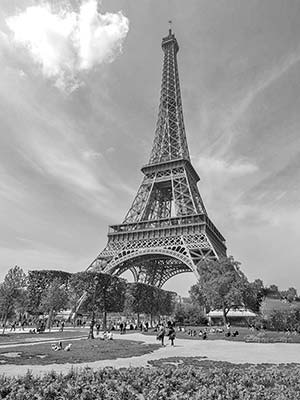
From the Eiffel Tower to Père Lachaise Cemetery
Champ de Mars and the Eiffel Tower
Tuileries Garden and Louvre Museum
Why pay €35 for a tour company to give you an overview of Paris when city bus #69 can do it for the cost of a Métro ride? Get on the bus and settle in for a trip through some of the city’s most interesting neighborhoods. Or use this tour as a handy way to lace together many of Paris’ most important sightseeing districts. On this ride from the Eiffel Tower to Père Lachaise Cemetery, you’ll learn how great Paris’ bus system is—and you’ll wonder why you’ve been tunneling by Métro under this gorgeous city. And if you’re staying in the Marais, Ile St. Louis, or Rue Cler neighborhoods, line #69 is a useful route for just getting around town. The end-of-the-line stop is right by the start of my Père Lachaise Cemetery Tour.
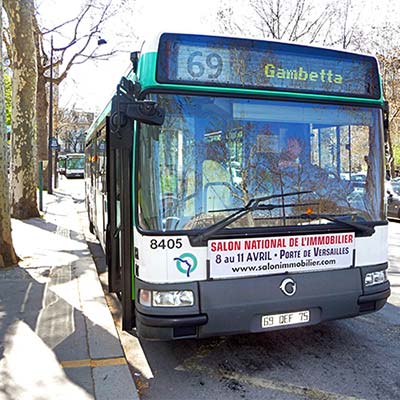
The bus often goes faster than you can read. It’s best to look through this chapter and peruse the map ahead of time, then ride with an eye out for the various sights described here.
Length of This Tour: Allow one hour. With limited time, get off at Bastille, with good Métro connections.
When to Go: You can board daily until 22:30 (last departure from Eiffel Tower stop). It’s best to avoid weekday rush hours (8:00-9:30 & 17:30-19:30). Sundays are quietest, and it’s easy to get a window seat. Evening bus rides are pretty from fall through spring (roughly Sept-April), when it gets dark early enough to see the floodlit monuments before the bus stops running—though some of the finer points are harder to see in the dark (and you’ll need a light to read this tour).
Getting There: Eastbound line #69 leaves from the Eiffel Tower on Avenue Joseph Bouvard (the street that becomes Rue St. Dominique as it crosses the Champ de Mars, two blocks from the tower through the park—for a more detailed view, see the map on here). Board at one of the first few stops to secure a view seat. The first stop is at the southwestern end of the avenue; the second stop is at the eastern end (just before Avenue de la Bourdonnais). Stops are located and clearly posted about every three blocks along the route. To see all the stop names, check the official Plan de Lignes at www.ratp.fr [URL inactive] (select “Timetables” if viewing in English, then “Bus,” then enter line number “69” in the box, then choose “Hours PDF” to see the route diagram). The map on here shows part of the bus #69 route.
Bus Fare and Tips: It might still be possible to buy a single-ride ticket from the driver, but it’s smarter to play it safe and use a Navigo card or pass that can be purchased at staffed Métro stations and most tabacs. A Navigo Découverte pass or all-day Navigo Jour card lets you use this route like a hop-on, hop-off bus to visit a bounty of sights (for details on these options, see here). Board through the front door, then validate your Navigo card in the machine behind the driver.
The buses are all quietly electric and have good air-conditioning. Push the red button to request a stop. Exit through the rear door. Buses run every 10-15 minutes except in the late evening. The time until the next bus is usually displayed at the bus stop.
Tours: Many sights along this route are covered in more detail elsewhere in the book. Many have self-guided tours and some have audio tours.  See the Eiffel Tower Tour, Orsay Museum Tour, Louvre Museum Tour, Left Bank Walk, Historic Paris Walk, Marais Walk, and Père Lachaise Cemetery Tour chapters.
See the Eiffel Tower Tour, Orsay Museum Tour, Louvre Museum Tour, Left Bank Walk, Historic Paris Walk, Marais Walk, and Père Lachaise Cemetery Tour chapters.  You can also download my free Historic Paris Walk, Orsay Museum, Louvre Museum, and Père Lachaise Cemetery audio tours.
You can also download my free Historic Paris Walk, Orsay Museum, Louvre Museum, and Père Lachaise Cemetery audio tours.
Handy line #69 crosses the city east-west, running between the Eiffel Tower and Père Lachaise Cemetery. In between, it passes close to these great monuments and neighborhoods: Ecole Militaire; Rue Cler; Les Invalides (Army Museum and Napoleon’s Tomb); the Rodin, Orsay, and Louvre museums; Ile de la Cité (Notre-Dame and Sainte-Chapelle); Ile St. Louis; Hôtel de Ville; Pompidou Center; Marais; and Bastille.
This tour is best done in the direction it’s written (east from the Eiffel Tower to Père Lachaise Cemetery)—in the other direction, one-way streets change the route. It’s still a scenic ride if going westbound—riders will pass through the Louvre courtyard, with its stunning pyramid aglow after dark.
Grab a window seat—either side toward the back is good (rear seats are higher). If you get on at one of the first stops, you’re likely to secure a good seat. Follow your progress by reading the stop names on the bus display or on the bus shelters you pass.
Many find the Bastille a good ending point (where you can begin this book’s walking tour of the Marais). This ride also ties in well after a visit to the Eiffel Tower or on your way to visiting Père Lachaise Cemetery. OK—let’s roll.
Your tour begins below this 1,000-foot, reddish-brown hood ornament. The park surrounding you is called the Champ de Mars (named for the god of war). It served as a parade ground for the military school, Ecole Militaire, which seals the park at the right end. Napoleon Bonaparte is the school’s most famous graduate.
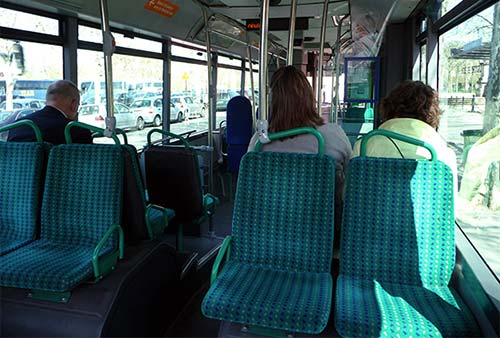
In 1889, the Champ de Mars was covered with a massive temporary structure to house exhibitions of all sorts; it was a celebration of the Centennial World’s Fair (the 100th anniversary of the French Revolution), the same event for which the Eiffel Tower was built. The apartments surrounding the park are among the most exclusive in Paris.
The grass that runs down the center of the park becomes a playground at night, when much of Paris seems to descend on it (it’s usually fenced off in off-season to give the grass a fighting chance). Picnics here are a delight, and warm evenings reveal Paris’ multicultural population. Dogs and kids romp as soccer balls fly past, all within the glow of the Eiffel Tower.
• Leaving the Champ de Mars, the bus slices through the 7th arrondissement along its primary shopping street.
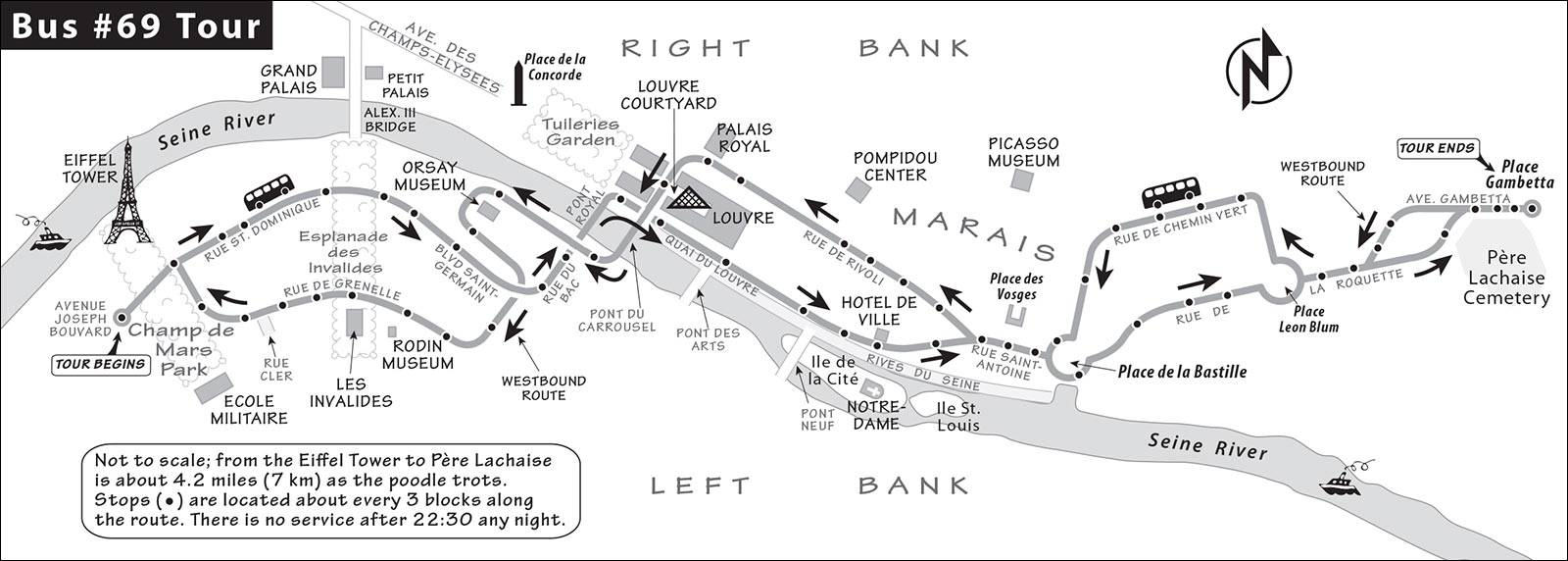
Paris functions as a city of hundreds of small neighborhoods. This area was once the village of Grenelle (before it was consumed by Paris). Many locals feel little need to leave the area, and neighbors trust each other. The dry cleaner knows that if customers forget to bring their wallets, they’ll return to pay another time. If the plumber can only come during work hours, locals can leave their apartment keys with the nearest shop owner.
This neighborhood has long been an attraction for Americans. The American Library is a block to the left after crossing Avenue de la Bourdonnais, the American University of Paris is on the far left as you cross Avenue Bosquet, the American Church sits on the river farther to the left, and the American Cathedral is just across the river, on the Right Bank.
• After crossing Boulevard de la Tour Maubourg, you’ll enter the open world of Esplanade des Invalides.
This sprawling green esplanade links the river (to the left) and Europe’s first veterans’ hospital, Les Invalides (right), built by Louis XIV. Napoleon lies powerfully dead under the brilliant golden dome.
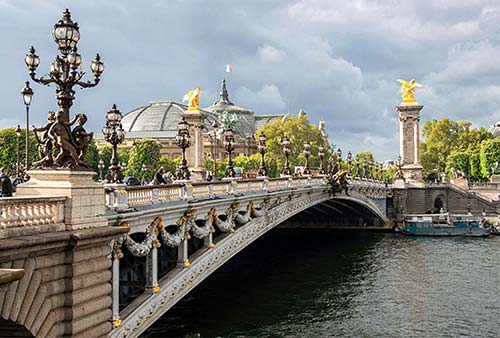
Look left and see the Pont Alexandre III (Alexander III Bridge) crossing the Seine. Spiked with golden statues and ironwork lamps, the bridge was built to celebrate a turn-of-the-20th-century treaty between France and Russia. Just across the bridge are the glass-and-steel-domed Grand and Petit Palais exhibition halls, built for the 1900 World’s Fair. Like the bridge, they are fine examples of belle époque architecture.
• Leaving Les Invalides, you’ll reenter narrow streets lined with...
Many of France’s most important ministries occupy these flag-bearing, golden-hued buildings with police guarding doorways, heavily barred windows, and people in suits speaking in hushed tones. The sprawling Ministry of Defense (on your left) was originally the mansion of Napoleon’s mother.
• After the Bellechasse stop, you’ll emerge from the government area onto the broad, stylish, and leafy...
Colorful home-decorating stores and fine Haussmann-era architecture mark this upper-crust neighborhood. The boulevard is famous for its cafés frequented by existentialists Simone de Beauvoir, Albert Camus, and Jean-Paul Sartre.
But we turn left onto Rue du Bac, with its art galleries, antique shops, and smart clothing boutiques. The Orsay Museum is just a few blocks to the left at the Pont Royal bus stop.
• Next, you’ll cross the river (with a view of the Orsay Museum behind on the left) and enter the Right Bank.
The lovely Tuileries Garden (Jardin des Tuileries), well worth a stroll, lies ahead and to the left after you cross the Seine. This was once the royal garden of the Louvre palace, which is just ahead and to the right.
The bus turns right on the Right Bank and begins to travel the entire length of the looooong Grand Gallery of the Louvre. Once the biggest building in the world, the Louvre’s 12 miles of galleries house some of the world’s greatest works of art. The medallions on the facade show the initials of each king who made his small contribution to building the massive Louvre. Notice the bus lane you’re in, separated from the slow-moving traffic by a low curb. Bicyclists have the right to use these lanes as well, making vast parts of Paris bike-friendly.
A few bridges ahead is the view-perfect pedestrian bridge Pont des Arts. Get off here if you’d like to take my self-guided Left Bank Walk. That curved building with a dome on the other side is where the Académie Française has met since the 1600s to compose the official French dictionary and defend the French language from corrupting influences (like English). Some 2,000 barges line the river below you.
The riverside promenade below, but out of view, was until recently an express lane carrying more than 20,000 cars per day. Now it accommodates strolling Parisians and bike riders (see my recommended bike route on here).
Lining the sidewalk on the right are the green metal stalls of bouquinistes—independent booksellers who have plied this trade along the Seine for centuries.
• As you roll past the end of the long Louvre building, on the right is the tree-lined tip of the narrow island called the...
Paris began here more than 2,000 years ago. The bridge you’ll pass is the Pont Neuf, or “new bridge,” though it’s now Paris’ oldest (1600).
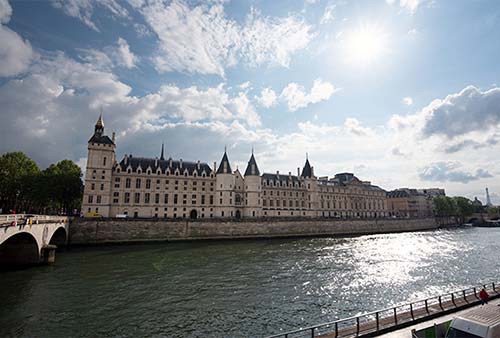
To your left, you’ll pass quirky plant shops and pet stalls. On the right, across the river, are the round towers (wearing pointy black cones) of the Conciergerie, where Marie-Antoinette was imprisoned during the French Revolution, awaiting the guillotine. Behind the Conciergerie is the slender spire of Sainte-Chapelle, with the most beautiful stained glass in Paris.
Farther ahead, on the right, you’ll see the tops of the twin towers of Notre-Dame Cathedral. The huge crane hovering above it will be visible for many years as the roof structure is rebuilt. (Châtelet is the best stop if you’d like to see the cathedral.)
Back to the left, the grand Hôtel de Ville (Paris’ City Hall) stands proudly behind playful fountains. Each of the 20 arrondissements (governmental areas) in Paris has its own City Hall, and this one is the big daddy of them all. It’s beautifully lit after dark all year.
• The bus turns left—away from the river. It angles past St. Gervais Church—one of the first churches built on the Right Bank—and into the Marais neighborhood.
This is jumbled, medieval Paris at its finest. On your left, a couple of blocks past St. Gervais Church near #13 (before the Jouy stop), stand some of the oldest houses in Paris—tall, skinny, and half-timbered. The Marais has been a swamp, an aristocratic district, and a bohemian hangout. Today, classy stone mansions sit alongside trendy bars, fashion boutiques, and top-notch museums—the Picasso Museum, Carnavalet, Victor Hugo’s House, Jewish Art and History Museum, and Pompidou Center.
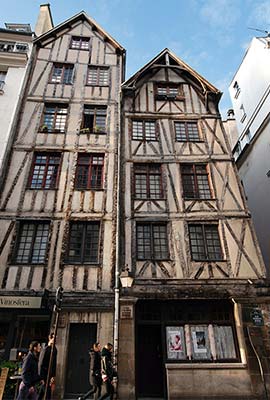
The narrow street merges into the boulevard Rue St. Antoine, the main street of Paris in medieval times. On the right, at #103, are the dome and red door of the small-but-grand Church of St. Paul and St. Louis—the only Jesuit church in Paris and the church where Victor Hugo prayed.
If you want to explore the charming Marais—stretching to the left of Rue St. Antoine—get off at the Bastille-Rue St. Antoine stop (after the Birague stop). You could do my Marais Walk, visit La Coulée Verte Promenade-Park (see here), or get a bite to eat (see the Eating in Paris chapter).
• Rue St. Antoine leads straight into Place de la Bastille, a vast round intersection with a giant pillar in the center.
This now-empty square is where the fortress-turned-prison called the Bastille once stood. For centuries, it was used to defend the city—mostly from its own people, becoming a symbol of royal tyranny. On July 14, 1789, angry Parisians swarmed the Bastille, released its prisoners, and kicked off the French Revolution. (The building was destroyed.) Since then, the French have celebrated Bastille Day every July 14 as enthusiastically as Americans commemorate July 4. The column in the middle of the square honors France’s ongoing struggle for democracy.
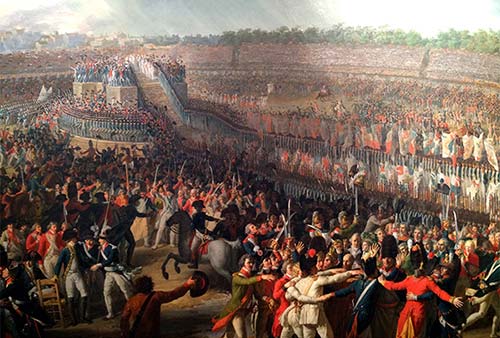
As you cross the square (usually a traffic mess—admire your driver’s patience and agility), you’ll pass over the covered Canal St. Martin, which runs under your feet from the Seine to northern Paris. Those red awnings lining the long boulevard to the left provide shade for vendors at one of Paris’ best outdoor markets, the Marché Bastille (see here). Next, you’ll curve in front of the reflecting-glass Opéra Bastille, today’s primary theater for the national opera company. Place de la Bastille (and surrounding streets) has become a trendy place for cafés and nightlife.
• Leaving Place de la Bastille, the bus angles left up...
This street gives a glimpse of the quirky, less-touristy Bastille neighborhood—an intriguing mix of galleries, wholesale clothing shops, seedy bars, and trendy eateries. The first street to the right is Rue de Lappe, one of the wildest nightspots in Paris, with a dizzying array of wacky bistros, bars, and dance halls.
The bus continues straight for about 10 minutes. As you go, notice how the cool cafés and chic boutiques give way to traditional businesses, though in Paris, you’re never more than a short walk from a café.
• The bus eventually turns left onto Boulevard de Ménilmontant (which locals happily associate with a famous Maurice Chevalier tune). From here, the bus travels alongside the wall of Père Lachaise Cemetery (on your right). Get off at Place Gambetta to visit the cemetery. As you exit the bus into the square, you’ll see its centerpiece—the grandiose City Hall for the 20th arrondissement. To reach Père Lachaise Cemetery from here, follow Avenue du Père Lachaise for 100 yards, past inviting cafés and flower shops selling cyclamen, heather, and chrysanthemums—the standard flowers for funerals and memorials—to the gate of the cemetery. Our bus tour is over. What better place for your final stop?
This renowned cemetery is the final resting place of many famous Parisians, as well as artists, writers, and musicians from around the world who found a home in the City of Light. The cemetery is located far from the center of old Paris because it’s relatively new—founded in 1804 by Napoleon to accommodate the city’s expansion. Follow my Père Lachaise Cemetery Tour to find the graves of greats such as Frédéric Chopin, Oscar Wilde, Gertrude Stein, Edith Piaf, and Jim Morrison.